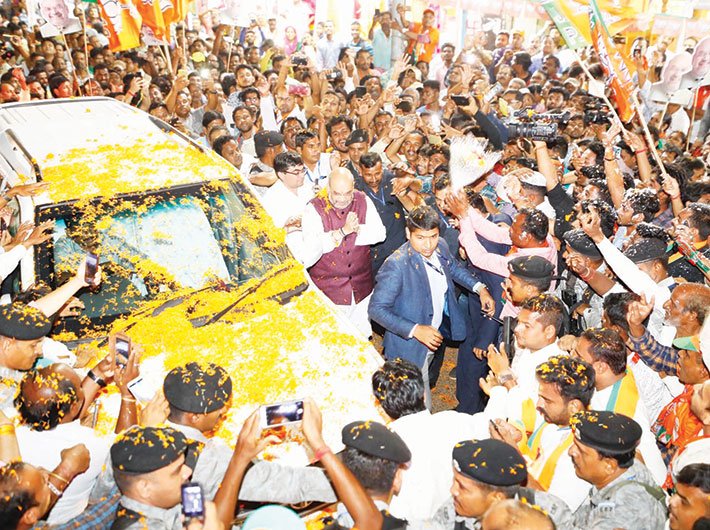The campaign in Odisha pits Modi against Patnaik, but it’s not clear if the tide will turn saffron
It’s early summer still in Odisha, but the state is already in the grip of an intense heat wave. In the last few weeks, many places have been regularly recording temperatures of 40 degrees Celsius and above. That doesn’t seem to have dampened the spirits of the four crore people of this state, where elections to the assembly and the Lok Sabha are being held simultaneously. Polling will be held in four phases and ends on April 29. “This once-in-five-years euphoria,” says a student at Bhubaneswar’s Utkal University, “will continue till the results are announced on May 23.”
But politicians are an anxious lot. None of them is sure which way the wind is blowing. The Congress, India’s oldest party, is in a mess in Odisha: there are internal conflicts and many senior leaders and MLAs have moved to the ruling Biju Janata Dal (BJD) or the Bharatiya Janata Party (BJP). The contest will practically be between the two latter parties.
Given chief minister Naveen Patnaik’s popularity and the grassroots strength of his BJD, it seems well ahead of the competition. Patnaik – his party has been in power for 19 years – seems all set for a fifth term. For the first time, however, the BJP is believed to be giving him a stiff challenge, both in a number of assembly segments and in a majority of the Lok Sabha seats.
Since Narendra Modi became prime minister in 2014, the BJP has kept Odisha in its focus. Modi and party chief Amit Shah have made repeated trips to the state. In fact Shah has set the BJP a target of 120 of the 147 assembly seats in the state. Central ministers Jual Oram and Dharmendra Pradhan and state-level BJP leaders have worked to galvanise grassroots workers and strengthen the BJP base.
“Everywhere, across the country, there is a tsunami of support for Modiji and the BJP. I haven’t seen such a wave in Odisha before. We are surely going to win in the state,” says BJP national general secretary Suresh Pujari. Rivals contest that claim, but concede that, as a senior Congress leader put it, “the BJD will continue to rule, but the BJP will win a number of seats”. Equally, a senior BJD leader says, “We will win, but the number of seats we get this time will be less. It will be interesting to see whether the BJP’s prominent visibility translates into votes.”
There’s no doubt, though, that Patnaik’s personal image remains intact after nearly two decades of ruling the state. Senior journalist Sandeep Sahu says the chief minister is extremely popular among rural folk and women; by proposing 33 percent reservation for women in assemblies and parliament, he has endeared himself with the latter further. “Patnaik’s honeymoon with voters continues,” says Sahu. “The 2019 elections will be a referendum on his 19 years in office.” Patnaik has also been helped by the fact that there is no credible face in the opposition camp at the state level.
However, the BJP is banking on the larger-than-life image projected by Modi. In fact, on the posters and in the ads, and on television debates and the campaign trail, it’s all about Patnaik versus Modi. Both sides are tom-tomming the pro-poor and development initiatives taken by Modi and Patnaik.
Sahu says that in 2014, Modi was not a factor in Odisha, as only city folks knew about him. But now, over five years of his being prime minister, everyone even in villages knows Modi. Post-Balakot, his popularity has only risen. “Modi is a big factor, no doubt,” says Sahu.
The Congress, however, finds itself cornered. Till the arrival of Patnaik, the Congress was the dominant force in Odisha politics. Troubled though the party is now, its leaders exude confidence. “Our party president Rahul Gandhi has promised that if voted to power, the Congress will immediately increase the minimum support price of paddy and waive farm loans like we did in Rajasthan, Madhya Pradesh and Chhattisgarh. Voters will surely opt for the Congress.
We will do very well,” says senior Congress leader and former minister Suresh Kumar Routray.
But his own party workers tell a different tale. In a voice loaded with sarcasm, a Congress leader says, “In the race among three parties, rest assured the third spot is ours.” But he believes the Congress will do well in at least two Lok Sabha seats. As far as assembly seats are concerned, his calculation is for 10-12 wins. “If our candidates win, it will purely be because of their continuous association with the people. Despite defeat, they have groomed their constituencies. Their victory can’t be credited to the party or our leadership.”
The real question to ask, though, is whether the main issues – corruption, the chit fund scam, law and order, anti-liquor movements by women – have any impact on the elections? Many experts believe corruption was never an issue for voters, but the chit fund scams and anti-liquor protests may go against the ruling party. The BJD government has been aggressively promoting the sale of liquor and in every instance of anti-liquor protests, the government machinery has acted against women agitators. “Their (the agitators) numbers could be less, but they can’t be ignored,” says Sahu. Another journalist, Rajib Sagaria, from Bolangir, says the hardships of farmers is perhaps the biggest issue in the state, but only the results will reveal if it has mattered during elections.
The 2014 election was a one-sided affair, with the BJD winning a whopping 117 assembly seats while the Congress got 16 and the BJP 10. And of the 21 Lok Sabha seats, the BJD had won 20, with one seat going to the BJP’s Jual Oram.
feedback@governancenow.com
(This article appears in the May 15, 2019 edition)
